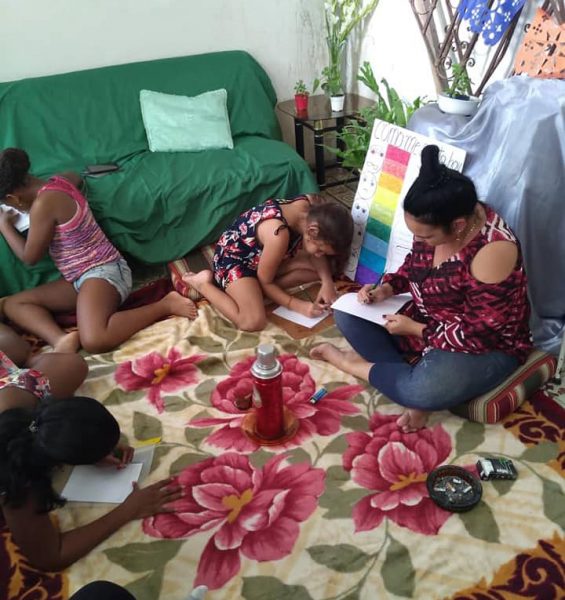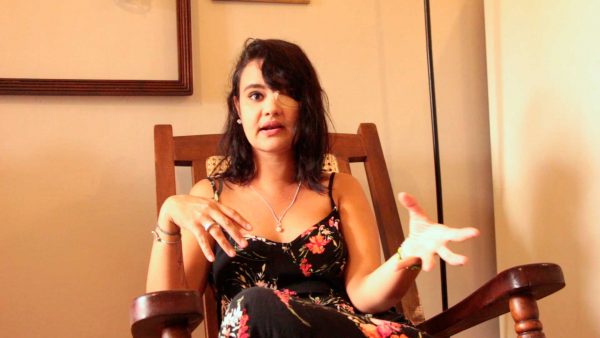A Space for Women in Havana’s San Isidro Neighborhood
By Lourdes Mederos (El Toque)

HAVANA TIMES – Maybe La Chiqui (as she prefers to be called) wouldn’t have said “I feel abused” before. It was normal for her. “I feel stronger now,” she says.
La Chiqui and other women from the San Isidro neighborhood in Havana have found a place where they can talk about their everyday problems during sessions of the project “Space for women’s dialogue and liberation”. When they meet, they talk about gender-based violence and its recurrence, the sexualization of childhood and self-esteem. Plus, they do healing and relaxation exercises, in which art and nature come together (planting a tree together, painting, reading poetry, etc.).
“When these kinds of problems come into your life, you tend to self-isolate. For example, they say that they used to hide their bruises from beatings, because it would be a sign of weakness if they didn’t,” Claudia Genlui explains, an art historian and the project’s coordinator. The objective is to connect women who have been abused, with an intimate conversation and debate about gender-related issues and artistic exercises.
She says that during her time as a curator in this community, she has seen problems that she identifies with. “I met women who were being abused and often didn’t even realize it,” she remembers. Even though she isn’t an expert in gender-related issues, she is convinced that art is a powerful tool to connect, heal and accompany these women.
The project has allowed La Chiqui to discover that she can count on other women like herself for support. “We have learned to come together to feel safe, because we mutually support each other with the problems we have.”
They have also tried to include men in these gatherings. “I am interested in getting both sexes to interact within this experience,” Genlui explains.
They also do healing and relaxation exercises, in which art and nature come together (planting a tree together, painting, reading poetry, etc.).

Physical distancing: reconfiguring opportunities
A living room, a park or a WhatsApp group are where these exchanges take place. The important thing is that they all feel comfortable and safe. When physical distancing began in the country as a response to the COVID-19 pandemic, the group’s dynamic shifted with the aim to continue strengthening this connection.
Even though the pandemic has stopped these women from seeing each other, they have managed to adapt to the new dynamics of their meetings. Conversations on social media have allowed them to continue to chat about their problems, identify their needs and find alternative support.
“I have seen many of them have more self-confidence after one of these sessions. One woman even set up a project to help disabled people during the pandemic,” Claudia Genlui says.
Understanding what gender-based violence and abuse means – in a neighborhood with a history of marginalization like San Isidro -, can be particularly challenging. Everyday life in these places has led to other difficulties, which means that sometimes they are forgotten from public and media agendas.

In the current landscape of a lack of an institutional system of support and intention, focus projects like this one are a great help, says Claudia.
“I think that every effort, whether it’s private or institutional, is valid when it comes to tackling a problem. I am in favor of every state-led project, which I don’t think are completely bad, but I do think that they need to be more in touch with Cuban reality. I would like to achieve this with ‘Space…’, a solid project which can really support a community. I dream of being able to provide psychological, economic and legal support for these women. I want this to become more than just a conversation, for it to really do something and for it to contribute towards improving the quality of life of each and every one of these women.”
La Chiqui believes that “Space…” should have been created a long time ago. “I hope that it continues, not just for me, but for all the women who need this strength and company.”
Gender-based violence outside of San Isidro
Psychologist and feminist Ailynn Torres has noted that “while in the world, 35% of women have suffered physical and/or sexual violence, at some point in their lives, at the hands of an intimate partner or sexual violence from another person other than their intimate partner, in Cuba, 39.6% of women have said they have been a victim in intimate partner relationships at some point in their life.”
While the debate about this issue has become more visible in recent times and even been the cause for civic organizing, there are several shortcomings in response services for domestic abuse victims. To name a few: shelters do not exist in the country and there are still barriers in women’s access to criminal justice in cases of gender-based violence.
There are other situations which are fostered because of structures of inequality, which make the social and economic landscape a lot more difficult for women to navigate. In the article “Welfare systems in Cuba: Women and inequality,” published in edition no. 39 of the Cuban Studies magazine, Torres offers a detailed map of many of these matters; including the low rate of Cuban women’s participation in the formal labor market, and the fact that women dedicate more hours to housework -14 hours more per week than their male counterparts, according to figures taken from the 2016 National Survey of Gender Equality.
With regard to femicide, while Cuba reports lower figures than other countries within the region, official statistics for 2016 (published in 2019) reveal that the femicide rate was 0.99 per 100,000 girls and women aged 15+. Approximately one woman is killed by her partner or ex-partner in Cuba, every week, according to the report.






Why don’t they meet in the local community centre?
Community centre – in Cuba?